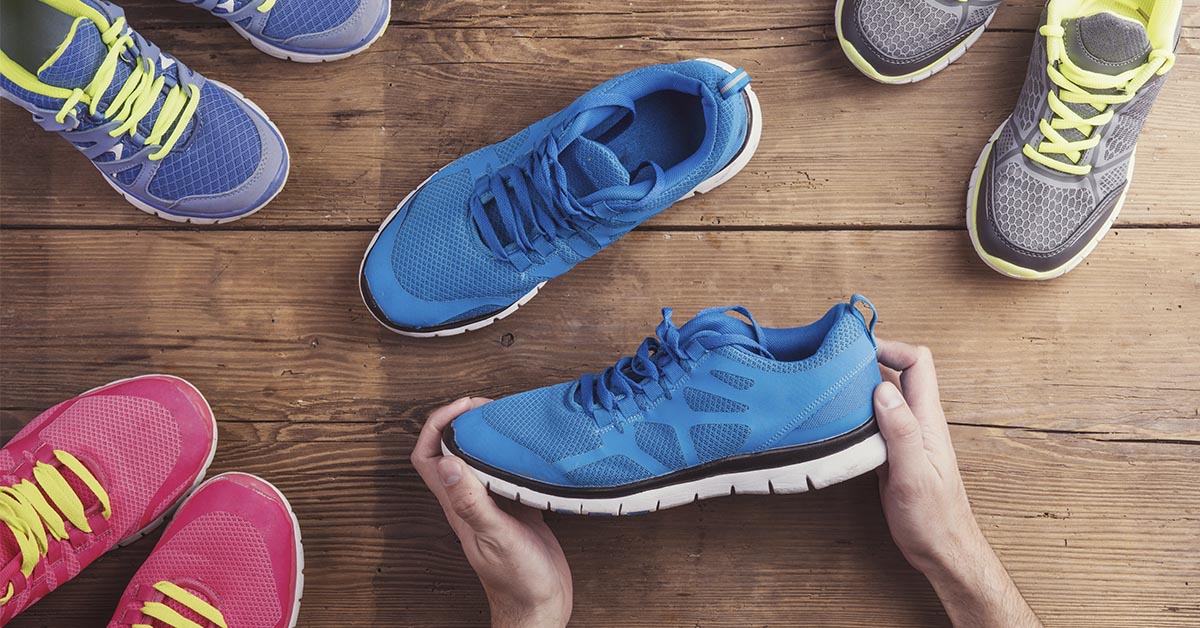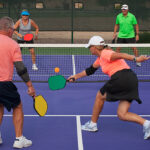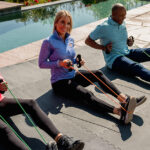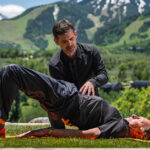
Footwear is such an important topic in the health and fitness world because having healthy and happy feet is a large component of being consistent with your exercise program and recreational activities. The two problems I see most often in the clinic when it comes to footwear are clients extending the life of their shoes too long and wearing a shoe that does not properly meet their needs.
Most of us are pretty lucky and are able to utilize shoes for many seasons and maybe even years without any issues. However, shoes that we wear often and hard (which are usually the shoes we are active in) need to be replaced more often than we think. Just because a shoe might be hole-free or still fairly clean, it doesn’t mean that it is still capable of providing both your feet and your entire lower body with the support they need for exercise.
My first rule of thumb is that shoes used for regular exercise and activity should never have a birthday. After months, let alone a year (or longer!) of being used on a weekly basis, the supportive components of the shoe start to break down and stop providing your body with the support it needs. A tell-tale sign that your shoes need to be replaced when your shoes outwardly look in good condition is that you are starting to feel abnormal aches and pains without any change in your activity level. Our bodies often send soft subtle messages that we overlook and how nice it would be to prevent a more chronic issue from developing with such a quick fix!
That leads to the question: “How often do I replace them?” The factors I take into consideration first are the following:
How often are the shoes worn?
Are they being used exclusively for exercise or also for daily activities, recreational walks, work, etc. If you want your exercise shoes to last longer, maybe invest in a pair for exercise only and then another for work or daily life that might fit the needs of those activities better and help give your exercise shoes some rest between workouts.
What kinds of activities are you wearing them for?
Are they worn for high-impact activities like running or low-impact activities like walking, resistance training, cycling, etc? Lower impact activities tend to be less stressful on the supportive components of the shoes thus extending their lifespan.
What is the quality of the shoe?
Sometimes investing a little bit more in a higher quality shoe will help extend the life of the shoe and even help you save money in the long run as you might not have to replace them as often
In my clinical experience, I have found that replacing shoes every 6-8 months is a good starting point if you only have one pair of exercise shoes. If you have a few pairs that you alternate wearing, usually you can get to that one-year mark pretty easily but likely don’t want to push it much past then.
Finding a rhythm for when you need to replace your athletic shoes is a little easier than finding a shoe that you really like. I highly recommend going to a well-known running store (they often carry other athletic shoes, not just running shoes) as they usually have staff qualified to analyze your walking/running pattern. I recommend many brands of athletic shoes and for different reasons so I focus on educating my patients on the different categories of athletic shoes and general considerations to use to help guide them in the right direction.
The general categories most brands of athletic shoes carry are a neutral shoe, motion control shoe, cushion shoe, minimalist shoe. Of course there are shoes specifically for hiking, cycling, dancing, etc. but activity-specific shoes can be broken down further as well, however for this post, we are going to keep it simple!
Here are some important points about each of the shoe categories listed above:
Neutral Shoes
These are great cross-training shoes. They can usually be used for weight/resistance training, moderate amounts of low-impact exercise, and light amounts of higher impact activity. They are also great for anyone who has custom orthotics as there are not strong components of stability built into the shoe so the custom orthotics really do their job.
Motion Control Shoe
Motion control shoes help those who need extra support in their foot and ankle. The shoe will have inherent arch support. The one downside is they tend to be heavier and clunkier which can impact how your lower body performs for extended periods of time.
Cushion Shoe
Cushion shoes have what their name implies, more cushion! They can be great for higher impact activities like running and jumping. However, they usually lack any supportive components for the foot and ankle, and for some that might make them inappropriate for their training. For example, for a short run or HIIT class, a cushion shoe would be nice. However, for marathon training or endurance activities, a more neutral shoe might be nice so as the foot fatigues with time there are some supportive elements built into the shoe.
Minimalist Shoe
A minimalist shoe is also what the name implies, minimal. They basically provide protection for the foot with a rubber sole and mesh covering. They have become more popular in the past 10 years for running and weight training however, they are not for everyone. Some of us have inherent parts of our lower body anatomy that we cannot fix with stretching, strengthening, working on balance, etc., and wearing a minimalist shoe, though it has its benefits for some, would likely cause more problems than rewards.

Now, this is just brushing the surface of footwear but I hope it has you thinking about how important proper footwear can be and how you’re are investing in your body and health when you invest in your shoes!
~ Blaire Brown, PT, DPT, OCS, SST
FITFOREVER Expert Trainer





